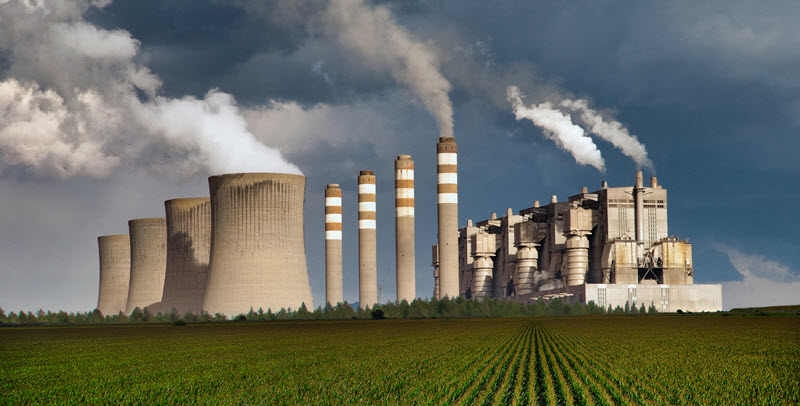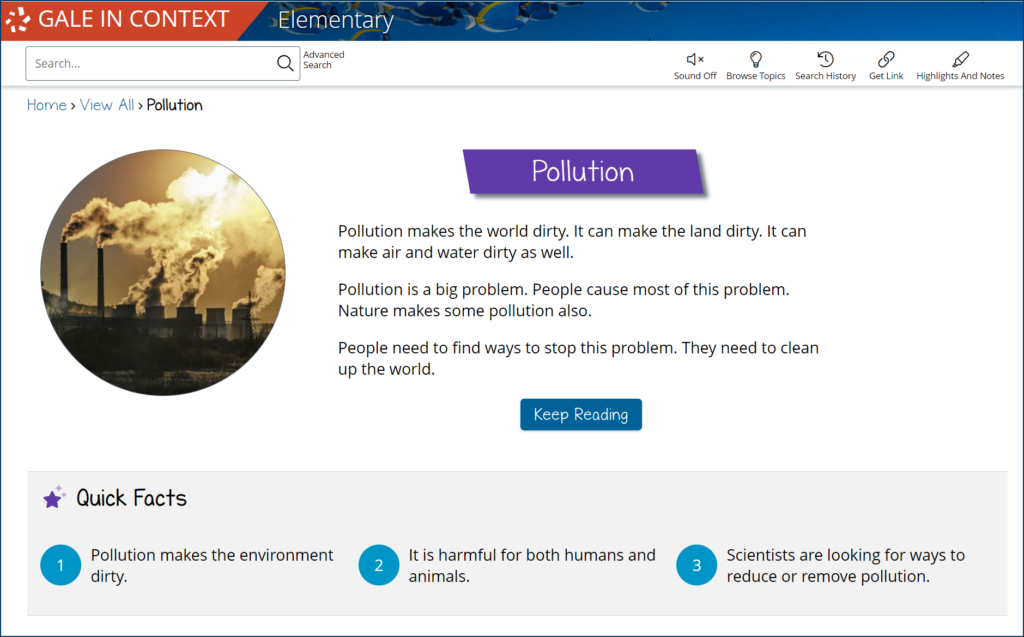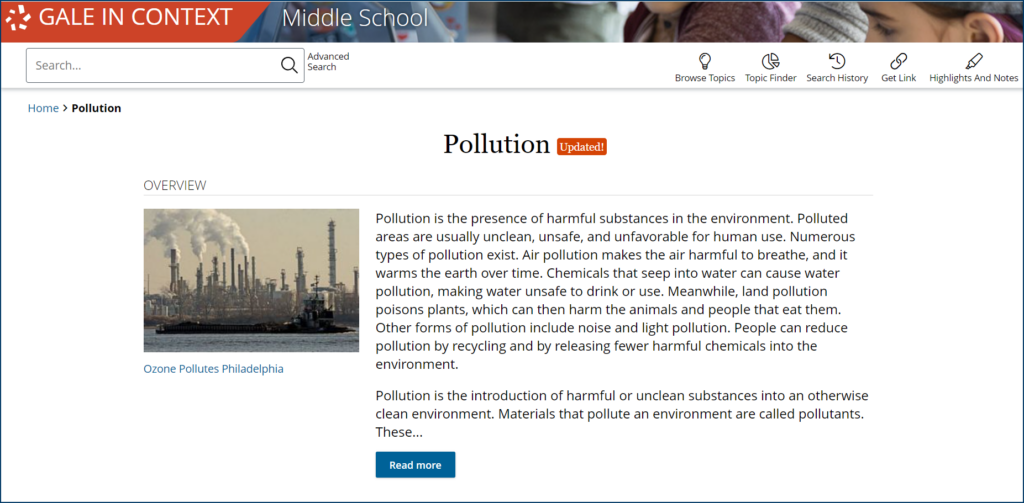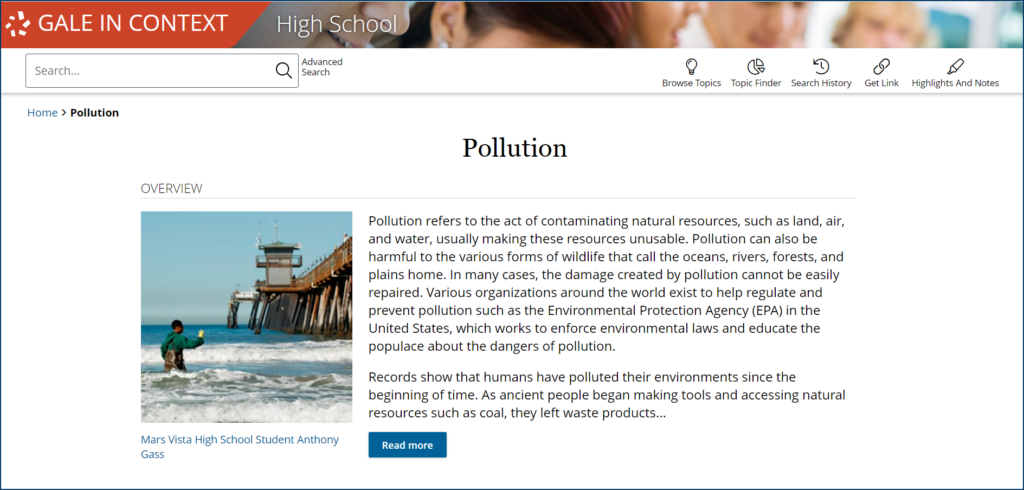| By Gale Staff |
Around midnight on December 2, 1984, several tons of methyl isocyanate (MIC) gas leaked from a factory in Bhopal, India. This deadly chemical, used in making pesticides, spread throughout the densely populated city. Thousands of residents died within the first few days of exposure, and still today, many survivors suffer from debilitating health issues. An astonishing 2023 study showed that the children of the survivors, born after the disaster, are at an elevated risk of cancer and disabilities.
The 1984 Bhopal gas tragedy was one of the worst industrial accidents in history. In remembrance, India observes December 2 as National Pollution Prevention Day. This is also an important opportunity to highlight the scale of environmental pollution and emphasize its negative consequences on people and our planet.
Take advantage of Gale In Context to learn about different aspects of pollution—and how everyone plays a part in preventing it. Gale In Context features customized databases for different grade levels: elementary, middle, and high school. We will explore the valuable nuances of these three databases, along with fascinating information about our environment and what we can do to protect it. With Gale, it’s easy to develop engaging activities and discussion questions to invigorate your lesson plans and motivate individual actions.
Elementary Learners: Discuss the Trouble With Trash
Pollution is a multi-dimensional topic, and its scale is challenging to grasp. Gale In Context: Elementary tackles big-picture problems and presents them to children in an engaging, age-appropriate format. Start with the database’s pollution topic page to find a kid-friendly pollution summary page and resources on related issues.
Elementary students have little control over their environmental footprints, but they do generate trash—usually in the form of plastic waste. This can provide a meaningful entry point for pollution-related discussions. Create a lesson plan for National Pollution Prevention Day around plastic garbage and responsible waste management.
The United States alone has thousands of landfills, and a large portion of their contents contain plastic waste. Plastic is particularly harmful to the environment because it releases dangerous chemicals as it breaks down. It’s also tough to clean up. Plastic is so prevalent in our environment that scientists find plastic waste inside animals, even as far away as Antarctica.
Discussion Idea: Many plastics can be recycled into building materials, containers, and art, but one of the best strategies to reduce plastic waste is to avoid using plastic in the first place. Encourage students to brainstorm ways they can use less plastic in their daily lives. Here are a few examples:
- Pack reusable silverware or disposable wooden utensils for lunchtime.
- Take canvas tote bags to the grocery store.
- Bring a reusable water bottle and reusable Tupperware to school.
- Choose fruit instead of snacks in plastic packaging.
Middle School Learners: Protect the Planet’s Most Precious Resource
Middle school educators can expand their pollution-themed lesson plans to encompass additional and more complicated topics. Explore the recently updated pollution topic page in Gale In Context: Middle School to find content that fosters their growing research abilities and critical thinking skills.
Water is the planet’s most valuable resource. Without water, life would not exist. Earth’s water has been around for millennia—it keeps getting recycled and repurposed through the natural water cycle. But if we continue to pollute the planet’s water sources, our species won’t survive.
Water pollution is a pervasive, multi-faceted problem. As we learned earlier, plastic waste is one piece of the puzzle—chemicals from plastics contaminate the water supply, and plastic waste harms aquatic ecosystems. Several other bad actors exist, including the fast fashion industry, which creates millions of tons of textile waste in our landfills, leaching dangerous chemicals from cheap dyes into the surrounding groundwater supply. Other significant sources of water pollution include:
- Natural runoff that carries contaminants into nearby bodies of water
- Agricultural fertilizers and pesticides
- Sewage overflow
- Industrial waste
- Fossil fuel spills
Activity Idea: Stopping big factories or fossil fuel companies from contributing to water pollution requires government intervention. However, plenty of meaningful water pollution prevention ideas can happen on the local level. One important strategy to fight water pollution is to deter stormwater from reaching major bodies of water with litter and chemicals that it may have picked up. Contain the pollution by building a rain garden at school! Rain gardens feature native, deep-rooted plants that capture and absorb stormwater during heavy rain.
High School Learners: Fight Fossil Fuels
High schoolers are ready for more in-depth, nuanced research, and Gale In Context: High School can help. So far, we’ve discussed plastic and water pollution, so let’s focus on a third: air pollution. Using the pollution topic page in Gale’s database, weigh the topic’s causes and risks to people.
Air pollution is not new or uncommon, but the problem has grown significantly as more countries industrialize and burn fossil fuels for energy. This process releases dangerous chemicals into the air, negatively impacting air quality and provoking severe health concerns. Air pollution causes respiratory diseases, cardiovascular diseases, and pregnancy-related complications, and has even been linked to heightened suicide rates. Fossil fuel emissions have depleted the ozone layer and are the greatest contributor to global climate change.
Air pollution has decreased in the United States in the past few decades, but these benefits aren’t shared equitably. Research suggests that socio-economic factors contribute to varying air pollution exposure. Specifically, low-income communities are often situated closer to major sources of air pollution (factories, roadways, ports), and these populations are more vulnerable to the associated health risks.
Consider Cancer Alley in Louisiana, where residents live alongside hundreds of petrochemical factories. In one town, the cancer rate is 50 times the national average. And if the Bhopal gas tragedy is any indication, exposure to dangerous pollutants can have devastating impacts for generations.
Discussion Idea: It’s no easy feat to clean the air. The best place to start is by limiting the energy we use—reducing the miles we travel by car, mindfully heating and cooling our homes, and supporting local food producers. Take it to the next level: students can write to state leaders and advocate for more climate-friendly policies. Does your state have a climate action plan? Are any climate-related bills up for debate? As a class, research these questions and maybe even write a letter to your state representative.
Pollution is a matter of concern for everyone, and we all have a part to play in its solutions. However, it’s particularly important that we initiate discussions on environmental issues as early as possible and integrate these lessons throughout K-12 education. By doing so, educators have the power to shape students’ environmental awareness and help them develop Earth-friendly habits they can carry with them throughout their lives.
Global pollution is a complicated topic with ever more complex solutions. Its repercussions are far-reaching, affecting not just the physical environment, but healthcare costs, politics, and social inequities. Because of its far-reaching consequences, pollution can be politically sensitive and even controversial. Gale In Context features vetted reputable sources to help your students immerse themselves in these topics without the threat of misinformation and bias from traditional search engines.
With help from Gale In Context, National Pollution Prevention Day is an opportunity to dive into this tangled web, frame the problem, and identify small, meaningful ways in which individuals can make a change.
If your school isn’t a current Gale subscriber, you can contact your local representative to learn more about our products.




